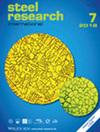利用等离子体活化固体碳前驱体的改良反应器配置对不锈钢进行等离子体渗氮的新方法
IF 1.9
3区 材料科学
Q2 METALLURGY & METALLURGICAL ENGINEERING
引用次数: 0
摘要
不锈钢表面可通过等离子体辅助热化学处理进行改性,以提高硬度、耐磨性和耐点蚀性等性能。为了有针对性地调整所需的性能,必须精确控制所产生的与处理相关的气体种类及其浓度。这就需要调整生成气体种类的参数,使其独立于加热参数,并对其进行实时测量。因此,本研究介绍了在奥氏体不锈钢的等离子软氮化过程中,在采用主动筛技术的冷壁反应器和改进型热壁反应器中使用等离子活化固体碳前驱体的情况。此外,改进型热壁反应器还结合了一个紧凑型激光吸收光谱传感器,用于实时监测和评估现场产生的气体种类的浓度。研究表明,在改良型热壁反应器中采用等离子体活化的固体碳前驱体,可以通过独立的电源管理实现含 C 气体物种(尤其是 HCN)的可调节生成,并且产量较高。因此,HCN 的产生与加热无关,同时避免了使用碳筛的活性筛技术所产生的限制。因此,所介绍的技术发展为更好地控制钢的等离子软氮化处理提供了新的可能性。本文章由计算机程序翻译,如有差异,请以英文原文为准。
New Approach for Plasma Nitrocarburizing of Stainless Steels by a Modified Reactor Configuration Using a Plasma‐Activated Solid Carbon Precursor
Stainless steel surfaces can be modified using plasma‐assisted thermochemical treatments to improve properties like hardness, wear, and pitting corrosion resistance. To specifically adjust the desired properties, a precise control of the produced treatment‐relevant gas species with regard to their type and concentration is essential. This requires the adjustment of the parameters for the generation of the gas species, being independent from heating parameters, as well as their real‐time measurement. Therefore, this study presents the use of a plasma‐activated solid carbon precursor in a cold‐wall reactor using active screen technology and in a modified hot‐wall reactor during plasma nitrocarburizing of austenitic stainless steel. In addition, the modified hot‐wall reactor combined with a compact laser‐based absorption spectroscopy sensor for real‐time monitoring and concentration evaluation of in‐site generated gas species. It is shown that implementing a plasma‐activated solid carbon precursor in a modified hot‐wall reactor enables adjustable generation of C‐containing gas species, particularly HCN, with high production yield by an independent power management. Therefore, HCN is produced independent from heating while the limitations arising during active screen technology using a carbon screen are avoided. The presented technological development thus opens up new possibilities for better control of the plasma nitrocarburizing treatments of steels.
求助全文
通过发布文献求助,成功后即可免费获取论文全文。
去求助
来源期刊

steel research international
工程技术-冶金工程
CiteScore
3.30
自引率
18.20%
发文量
319
审稿时长
1.9 months
期刊介绍:
steel research international is a journal providing a forum for the publication of high-quality manuscripts in areas ranging from process metallurgy and metal forming to materials engineering as well as process control and testing. The emphasis is on steel and on materials involved in steelmaking and the processing of steel, such as refractories and slags.
steel research international welcomes manuscripts describing basic scientific research as well as industrial research. The journal received a further increased, record-high Impact Factor of 1.522 (2018 Journal Impact Factor, Journal Citation Reports (Clarivate Analytics, 2019)).
The journal was formerly well known as "Archiv für das Eisenhüttenwesen" and "steel research"; with effect from January 1, 2006, the former "Scandinavian Journal of Metallurgy" merged with Steel Research International.
Hot Topics:
-Steels for Automotive Applications
-High-strength Steels
-Sustainable steelmaking
-Interstitially Alloyed Steels
-Electromagnetic Processing of Metals
-High Speed Forming
 求助内容:
求助内容: 应助结果提醒方式:
应助结果提醒方式:


